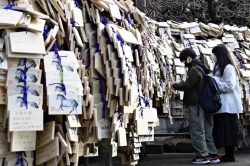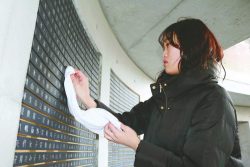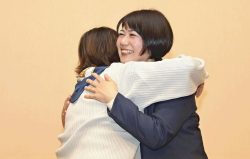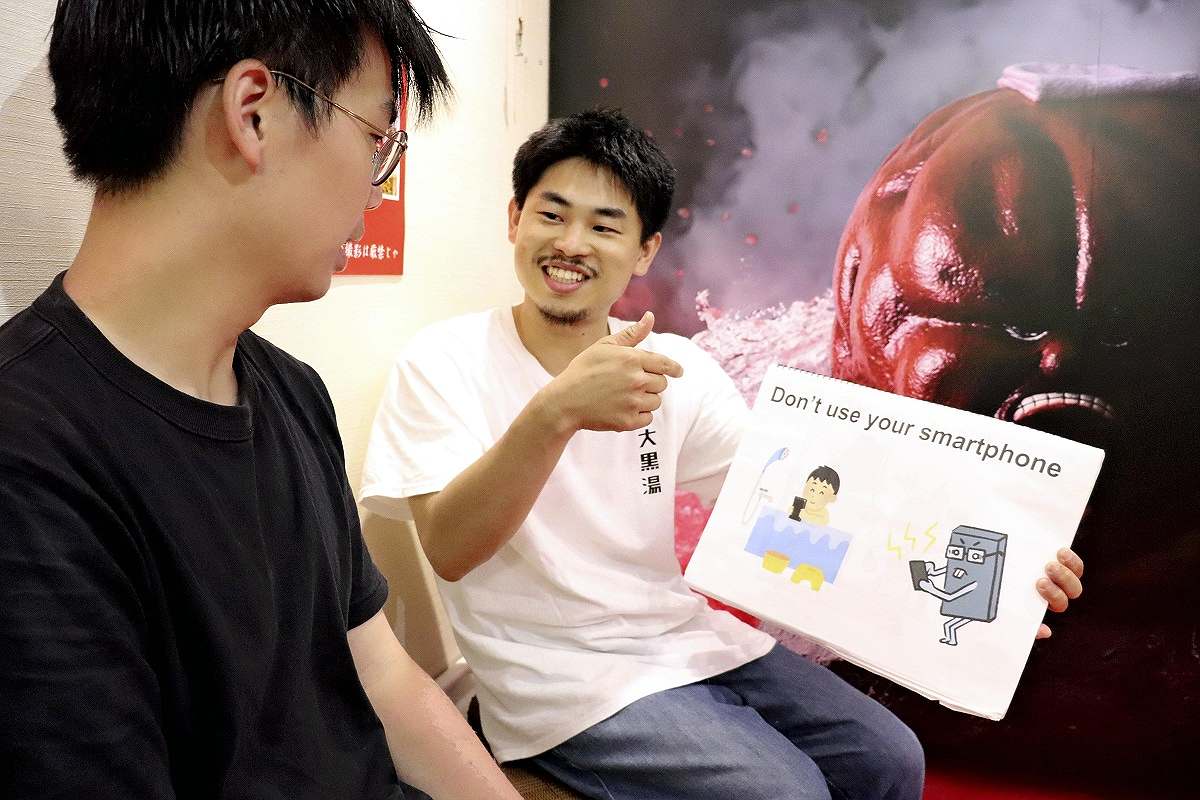
Kenshi Naito, a Daikokuyu employee, teaches Cheng Dian Heng from Taiwan sento etiquette using illustrations, in Sumida Ward, Tokyo.
1:00 JST, October 15, 2024
“Don’t use your smartphone.” Kenshi Naito, an employee of Daikokuyu, a sento public bathhouse in Sumida Ward, Tokyo, showed the message written on an illustrated card to Cheng Dian Heng, a visitor from Taiwan.
Naito, 28, was teaching Cheng, 21, bathing etiquette using large illustrations created specifically to teach foreign tourists sento rules. This was Cheng’s third visit to Japan but his first time at a public bathhouse.
Naito explained in English what to do at a public bathhouse, such as showering before entering the large bath and drying off before returning to the dressing room.
Cheng said he was happy to learn about the things he did not know before.
“In other countries, there are no public baths. There is nothing in Taiwan. So, it is a special experience for me,” he added.
The illustrations were created for Sentorance Japan, a sento tour launched this year by Kanazawa Yokujo, a company that operates Daikokuyu and Koganeyu, another public bathhouse in Sumida Ward.
Sentorance, a combination of the words “sento” and “entrance,” is a term that was created in the hope that sento will serve as an entrance to Japanese culture.
The tour includes a lecture on sento etiquette using the illustrations, followed by taking a bath at a bathhouse.
Daikokuyu attracts tourists from various countries and territories, partly due to its location, which is only about a 10-minute walk from Tokyo Skytree, a popular tourist destination.
The problem was that many foreign tourists did not know bathing etiquette, leading to some locals becoming annoyed. To deal with the issue, the company organized the tour so that foreign tourists could enjoy their first sento experience.
Naito serves as a guide, drawing from his experience of working at a hotel for a year while on a working holiday in Canada.
The tour is advertised on the company’s social media as well as on posters hung in sento, attracting the interest of many people.
“Many sento are facing financial difficulties,” Naito said. “To survive, it is important for them to attract foreign visitors as well as Japanese people. I hope the sento culture will spread all over the world.”
Part of everyday life
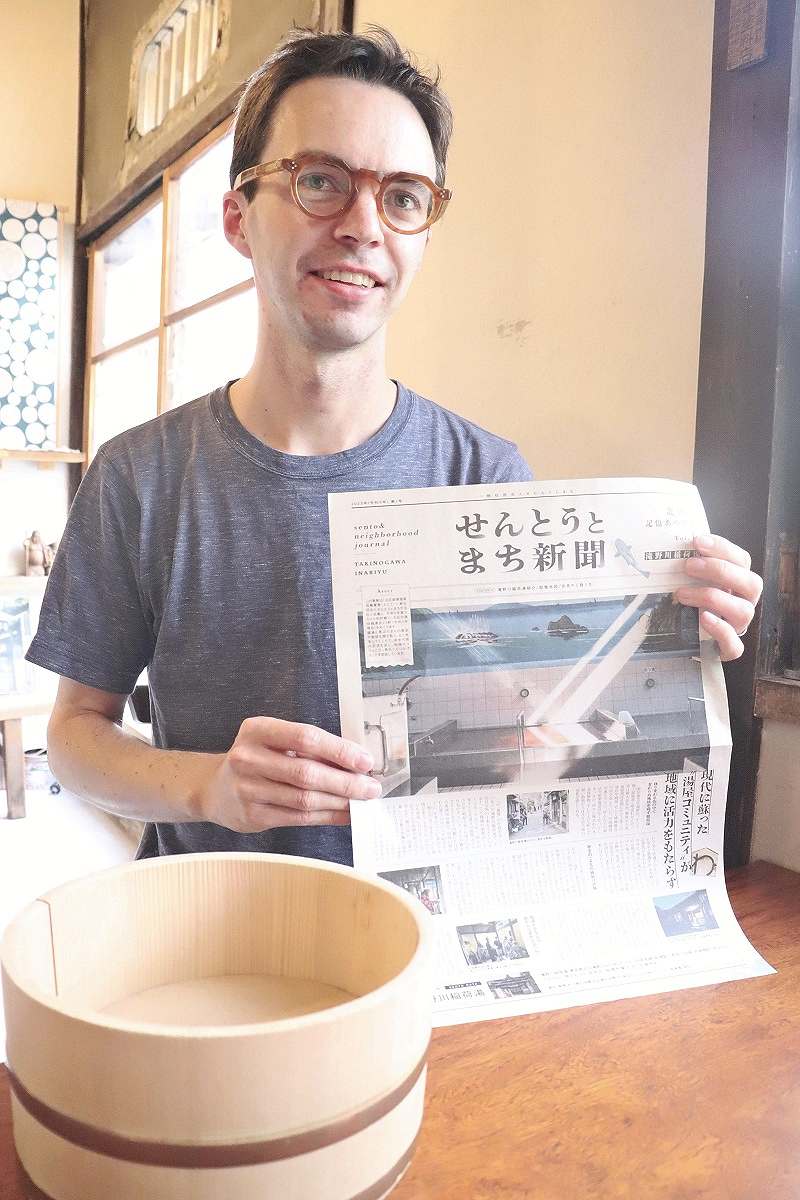
Sam Holden poses for a photo in Kita Ward, Tokyo, with a newsletter promoting sento.
Interest in Japan’s sento culture is growing overseas, says Sam Holden, 34, director of Sento & Neighborhood, a general incorporated association in Bunkyo Ward, Tokyo. The association works to preserve sento nationwide.
Holden, an American from Colorado, began going to sento around 2014, when he was studying urban sociology at the University of Tokyo’s graduate school.
He started noticing that there were many sento in residential areas, where produce shops, tofu stores and barber shops are also located. He also observed that it was not uncommon to find sento in wooden buildings that were more than 50 years old. Holden realized that sento were closely linked to the lives of the local people.
He also found it comfortable being around local residents and sharing their daily routines while bathing in a building that is steeped in history.
Many countries do not have a culture in which strangers bathe together in public bathhouses.
“There is no problem once we got used to it,” Holden said.
He also said he felt soothed by the sento atmosphere in which everyone can relax while bathing.
When a few sento near his home in the Hongo district of Bunkyo Ward went out of business, he learned that more and more of them in Tokyo were permanently closing.
Holden views sento as invaluable places where people can experience everyday life and thinks that it would be a shame if such wonderful places disappeared. He then decided to support sento and their revitalization.
As part of Sento & Neighborhood’s activities, he was involved in the renovation of an unoccupied nagaya row house next to Takinogawa Inari-yu, a long-established sento in Kita Ward. Since its renovation, the building also serves as a community space, which local businesses can rent for events or other purposes.
Visitors to the building can read Sento & Neighborhood’s newsletter published by the organization that conveys the charm of sento and their neighborhoods with the aim of familiarizing readers with public bathhouses.
These efforts have been reported on by foreign media, helping to attract foreign tourists in addition to Japanese people.
Holden says that to attract people from overseas who are not familiar with sento, it is important to make sento feel accessible by giving visitors the necessary information. For example, some people do not know where to take off their shoes.
Holden also advises sento owners to show that foreign visitors are welcome, saying that speaking English well is not necessary, and visitors and employees can communicate with each other through gestures.
“Sento are one of Tokyo’s major attractions, and they can be used more as a tourism resource to attract foreign visitors. I will communicate the value and importance of sento culture. I think it must also be passed on to future generations,” Holden said enthusiastically.
"Society" POPULAR ARTICLE
-

Tokyo Zoo Wolf Believed to Have Used Vegetation Growing on Wall to Climb, Escape; Animal Living Happily after Recapture
-

Israeli Tourists Refused Accommodation at Hotel in Japan’s Nagano Pref., Prompting Protest by Israeli Embassy and Probe by Prefecture
-

Snow Expected in Tokyo, Neighboring Prefectures from Jan. 2 Afternoon to Jan. 3; 5-Centimeter Snow Fall Expected in Hakone, Tama, and Chichibu Areas
-

JAL, ANA Cancel Flights During 3-day Holiday Weekend due to Blizzard
-

Tokyo, Yokohama Observe First Snowfall of Season; 1 Day Earlier than Average Year
JN ACCESS RANKING
-

As Chinese Tourists Shun Japan, Hotels and Stores Suffer
-

Core Inflation in Tokyo Slows in December but Stays above BOJ Target
-

Osaka-Kansai Expo’s Economic Impact Estimated at ¥3.6 Trillion, Takes Actual Visitor Numbers into Account
-

Japan Govt Adopts Measures to Curb Mega Solar Power Plant Projects Amid Environmental Concerns
-

BOJ Gov. Ueda: Highly Likely Mechanism for Rising Wages, Prices Will Be Maintained


